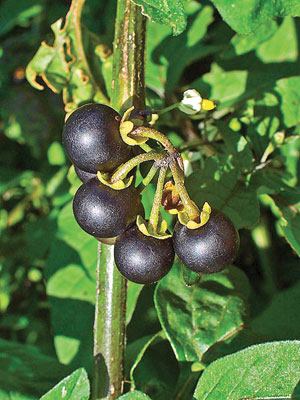Dangers could be lurking in pastures across the Ozarks, dangers that can be fatal to livestock.
There are many plants commonly be found in pastures, both native and improved, along fence rows and other areas that are potentially toxic to livestock, such as Johnson grass, water and poison hemlock, black nightshade, wild cherry and milkweed.
Luckily, many of these plants taste bad, so livestock doesn’t typically graze upon them.
“Most of them, the cows won’t eat unless they are forced to eat them; things like hemlock, nightshade and such,” University of Missouri Extension Agronomy Specialist Terry Halleran, who is based in Hickory County, Mo., said. “They really don’t go looking for them.”
Hugh Aljoe, producer relations manager and pasture and range consultant with the Samuel Roberts Nobel Foundation in Oklahoma, cautioned that cattle brought in from areas where there were never exposed to toxic plants can also be at risk, but herd on a well managed pastures will turn their noses to most dangerous plant species.
“If you force them onto it or put them in a dry lot to hold them for a short period of time, they might be forced to try and consume something they would normally avoid.
Most plants are only dangerous during certain periods in their life cycle, and may be perfectly fine after being cut in hay. For example, the leaves and stems of buttercups contain toxins, but those toxins volatilize upon drying; therefore, buttercups contained in dried hay do not pose toxicity problems.
Mature Johnsongrass in well-dried hay also poses no danger to cattle, but Aljoe said it is the most “worried about” poisonous plant.
“There is sort of a balance you have to do with Johnsongrass,” he said. “It is one of the plants that cattle like; it’s kind of like the ice cream plant in the pasture and as a result, cattle are attracted to it. If you put it up in hay, the prussic acid cures, so it isn’t an issue in the hay,” Aljoe said. “On the other hand, if you fertilized it and you have nitrates, it doesn’t cure out. You can cut it and the levels will stay the same in the hay, so you have to be able to identify the issue you are dealing with.”
He added that wether conditions can cause Johnsongass, and other species of plants to turn toxic overnight.
“It can be stress through frost or, especially this time of year, dry conditions, drought stress,” Aljoe added. “Typically, the regrowth is the most toxic. If you have plants that have been grazed a little and there is regrowth that is less than 18 inches tall, particularly in the morning, and cattle can be dead before you get out there to check them. If you are in some kind of rotation where you are rotating cattle from pasture to pasture, the ideal situation is not to leave them in a pasture for more than five days and not come back for 30. You want to make sure that regrowth gets over 18 inches before you hit it again.”
There are several resources available for producers to help identify dangerous plants, and what control measures work best to eliminate those plants from pastures.
Halleran said spraying at the right time during the plant’s growth cycle is important for eliminating the threat of poisonous plants.
“You want to make sure there is enough leaf surface for the chemical to get on it and be absorbed,” he said. “If you are spraying before (the plant) gets to be about 4 inches or so, you may not get as good a kill as you might like, but you need to get them sprayed before they get to be 12 inches or so. Timing also has a lot to do with it, depending on if it is a cool or warm season plant, a C3 or a C4 plant, or the time of year when you spray.”
The most important tool in fighting poisonous weeds is education.
“If you haven’t been to some kind of in-field pasture demonstration, go somewhere where they have a forage specalist that can help you identify what those plants are,” Aljoe said. “If you don’t, you need to look at some pasture guides.”
Extensions and chemical companies offer a wide range of literature, many times at no cost, to producers to help identify poisonous plants and invasive weeds, as well as tips for control measures for a particular species.
Halleran and Aljoe cautioned producers to educate themselves on the products they use in fields and pastures. Many products restrict when cattle can graze the area, and those restrictions can be different for lactating animals.
“Also, there are restrictions on how soon you can reintroduce any type of new seed for legumes. If you put Grazon in a field, you can’t put in red cover for 15 to 18 months because it will kill it. Read the entire label, not just the part with how to put it on and what it kills,” Halleran added. “Don’t skip things.”
Producers should also be aware of any shrubs, non-native or ornamental plants or trees that may be in pastures. Boxwood shurbs, for example, are highly lethal to livestock. When pruning shrubs or trees, it is important that livestock have no access to clippings. Wilted leaves cut from a bush or tree can actually be more toxic the live plant.
For more information on plants that can be harmful to livestock, go to ozarksfn.com and go to the “Extended Stories” link.






